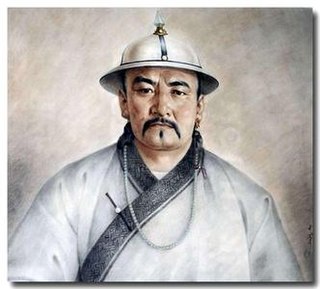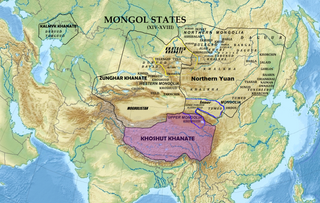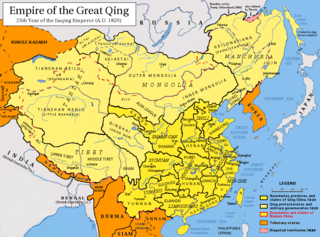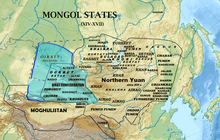
The Mongols are an East Asian ethnic group native to Mongolia, China, as well as Buryatia and Kalmykia of Russia. The Mongols are the principal member of the large family of Mongolic peoples. The Oirats in Western Mongolia as well as the Buryats and Kalmyks of Russia are classified either as distinct ethno-linguistic groups or subgroups of Mongols.

Kalmyks are the only Mongolic-speaking people living in Europe, residing in the easternmost part of the European Plain.

The Dzungar Khanate, also written as the Zunghar Khanate or Junggar Khanate, was an Inner Asian khanate of Oirat Mongol origin. At its greatest extent, it covered an area from southern Siberia in the north to present-day Kyrgyzstan in the south, and from the Great Wall of China in the east to present-day Kazakhstan in the west. The core of the Dzungar Khanate is today part of northern Xinjiang, also called Dzungaria.

Oirats or Oirds, also formerly Eluts and Eleuths, are the westernmost group of the Mongols whose ancestral home is in the Altai region of Siberia, Xinjiang and western Mongolia.

The Khalkha or Kalka have been the largest subgroup of Mongol people in modern Mongolia since the 15th century. The Khalkha, together with Chahars, Ordos and Tumed, were directly ruled by Borjigin khans until the 20th century; unlike the Oirats, who were ruled by Dzungar nobles or the Khorchins, who were ruled by Qasar's descendants.

The Dörbet is the second largest subgroup of Mongol people in modern Mongolia and was formerly one of the major tribes of the Four Oirat confederation in the 15th-18th centuries. In early times, the Dörbets and the Öold were overruled by collateral branches of the Choros lineage. The Dörbets are distributed among the western provinces of Mongolia, Kalmykia and in a small portion in Heilongjiang, China. In modern-day Mongolia, the Dörbets are centered in Uvs Province.

Erdeniin Galdan, known as Galdan Boshugtu Khan was a Choros Dzungar-Oirat khan of the Dzungar Khanate. As fourth son of Erdeni Batur, founder of the Dzungar Khanate, Galdan was a descendant of Esen Taishi, the powerful Oirat Khan of the Northern Yuan dynasty who united all Mongols in the 15th century. Galdan's mother Yum Aga was a daughter of Güshi Khan, the first Khoshut-Oirat King of Tibet.

The Torghut are one of the four major subgroups of the Four Oirats. The Torghut nobles traced their descent to the Mongol Keraite ruler Toghrul, and many Torghuts descended from the Keraites.

Queen Anu or Lady Anu was a queen consort who led warriors into battle at the founding of the Dzungar Khanate in the late 17th century.

The Zakhchin is a subgroup of the Oirats residing in Khovd Province, Mongolia. Zakhchin means 'Border people'. They are so called because they originated from the border garrison of the Dzungar Khanate. They originally spoke the Zakhchin dialect of the Oirat language, but actually pure Oirat language is used by elder generations, younger generations use a dialect being under a strong Khalkha influence.
The Bayad is the third largest subgroup of Mongol people in modern Mongolia and they are a tribe in Four Oirats. Baya'ud were a prominent clan within the Mongol Empire. Baya'ud can be found in both Mongolic and Turkic peoples. Within Mongols, the clan is spread through Khalkha, Inner Mongolians, Buryats and Oirats.

Choros or Tsoros was the ruling clan of the Ööld and Dörbet Oirat and once ruled the whole Four Oirat. They founded the Dzungar Khanate in the 17th century. Their chiefs reckoned their descent from a boy nourished by a sacred tree.

The Dzungar people are the many Mongol Oirat tribes who formed and maintained the Dzungar Khanate in the 17th and 18th centuries. Historically, they were one of the major tribes of the Four Oirat confederation. They were also known as the Eleuths or Ööled, from the Qing dynasty euphemism for the hated word "Dzungar", and as the "Kalmyks". In 2010, 15,520 people claimed "Ööled" ancestry in Mongolia. An unknown number also live in China, Russia and Kazakhstan.
The Four Oirat ; also Oirads and formerly Eleuths, alternatively known as the Alliance of the Four Oirat Tribes or the Oirat Confederation, was the confederation of the Oirat tribes which marked the rise of the Western Mongols in the history of the Mongolian Plateau.

The Khoshut Khanate was a Mongol Oirat khanate based in the Tibetan Plateau from 1642 to 1717. Based in modern Qinghai, it was founded by Güshi Khan in 1642 after defeating the opponents of the Gelug school of Tibetan Buddhism in Tibet. The 5th Dalai Lama established a civil administration known as Ganden Phodrang with the aid of Güshi Khan. The role of the khanate in the affairs of Tibet has been subject to various interpretations. Some sources claim that the Khoshut did not interfere in Tibetan affairs and had a priest and patron relationship between the khan and Dalai Lama while others claim that Güshi appointed a minister, Sonam Rapten, as de facto administrator of civil affairs while the Dalai Lama was only responsible for religious matters. In the last years of the khanate, Lha-bzang Khan murdered the Tibetan regent and deposed the 6th Dalai Lama in favor of a pretender Dalai Lama.

The Kalmyk Khanate was an Oirat khanate on the Eurasian steppe. It extended over modern Kalmykia and surrounding areas in the North Caucasus, including Stavropol and Astrakhan. During their independence, the Kalmyks both raided and allied with Russia in turn, engaging in numerous military expeditions against the Crimean Tatars, the Ottoman Empire, neighboring Muslim tribes, and the highlanders of the North Caucasus. The Khanate was annexed by the Russian Empire in 1771.

The Dzungar–Qing Wars were a decades-long series of conflicts that pitted the Dzungar Khanate against the Qing dynasty and its Mongol vassals. Fighting took place over a wide swath of Inner Asia, from present-day central and eastern Mongolia to Tibet, Qinghai, and Xinjiang regions of present-day China. Qing victories ultimately led to the incorporation of Outer Mongolia, Tibet and Xinjiang into the Qing Empire that was to last until the fall of the dynasty in 1911–1912, and the genocide of much of the Dzungar population in the conquered areas.
The Abagas are a Southern Mongolian ethnic groupe in Abag Banner, Inner Mongolia, China.

The Qing dynasty in Inner Asia was the expansion of the Qing dynasty's realm in Inner Asia in the 17th and the 18th century AD, including both Inner Mongolia and Outer Mongolia, both Manchuria and Outer Manchuria, Tibet, Qinghai and Xinjiang.

Dawachi was the last khan of the Dzungar Khanate from 1753 until his defeat at the hands of Qing and Mongol forces at Ili in 1755.













